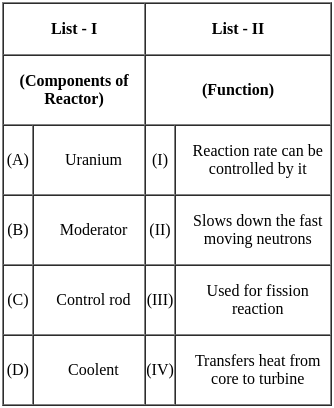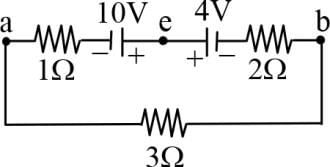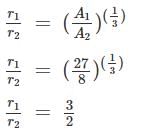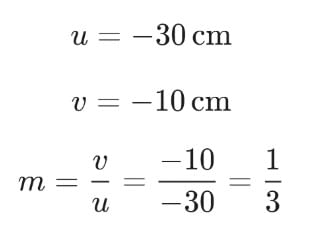Physics: CUET Mock Test - 5 - CUET MCQ
30 Questions MCQ Test CUET UG Mock Test Series 2026 - Physics: CUET Mock Test - 5
Calculate the value of peak reverse voltage (P.I.V.) if the full-wave rectifier has an alternating voltage of 300 V.
Emission of electron from the surface of metal when radiation of appropriate frequency is allowed to incident on it is called :
An electron, an alpha particle, a proton and a deutron have the same kinetic energy. Which of these particles has the shortest De Broglie wavelength.
The ratio of radii of two nuclei having atomic mass numbers 27 and 8 respectively, will be:
 years, then the amount of substance left after 12 years is :
years, then the amount of substance left after 12 years is :
Match List - I with List - II.

Choose the correct answer from the options given below :
Which of the following statement is correct?
I. Refraction is due to the change in the speed of light when it enters from one transparent medium to another.
II. The refractive index of water is 1.33.
Consider the statements and choose the correct option.
Assertion (A): A magician during a show makes a glass lens with n = 1.47 disappear in a trough of liquid.
Reason (R): The refractive index of the liquid must be equal to 1.47 in order to make the lens disappear.
A cylindrical wire of radius R has current density varying with distance r from its axis as The total current through the wire is
The total current through the wire is
In the circuit shown in Fig., the reading of the ammeter is (assume internal resistance of the battery to be zero)

Drift is the random motion of the charged particles within a conductor,
In the circuit diagram shown below, the magnitude and direction of the flow of current, respectively, would be

An electron and proton enter a magnetic field with equal velocities. Which one of them experiences a greater force?
In which case is electron emission from a metal not known?
Given h = 6.6 ×10−34 joule sec, the momentum of each photon in a given radiation is 3.3 ×10−29 kg metre/sec. The frequency of radiation is
If the work function of a material is 2eV, then minimum frequency of light required to emit photo-electrons is
Electric potential due to a point charge q at a distance r from the point is _______ (k = 1).
The frequency of ac is doubled. How does XL get affected?
Pick out the correct combination for a step-up transformer.
At what frequency will a coil, which has an inductance of 2.5 H, have a reactance of 3500 Ω?
In Young’s double-slit experiment if the distance between two slits is halved and distance between the slits and the screen is doubled, then what will be the effect on fringe width?
An object is to be seen through a simple microscope of power 10 D. Where should the object be placed to reduce maximum angular magnification? The least distance for distinct vision is 25 cm.
What is the rms value of output current if the peak value of output current is given as 0.092 A?
The object distance of a lens is -30 cm and image distance is -10 cm. Find the magnification of the lens. With the help of this, decide whether the size of the image is smaller or bigger than the size of the object.
Radioactive material decays by simultaneous emission of two particles with respective half-lives 1620 and 810 years. The time, in years, after which one-fourth of the material remains?
|
39 docs|145 tests
|












 = 1080 year.
= 1080 year.










